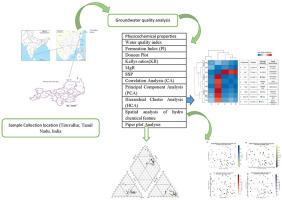Unified model for groundwater quality assessment using multivariate statistical techniques and geospatial approaches in northern Tiruvallur, Tamil Nadu, India
IF 4.1
3区 地球科学
Q2 GEOSCIENCES, MULTIDISCIPLINARY
引用次数: 0
Abstract
This study presents an integrated hydrochemical assessment of groundwater in the northern Tiruvallur District, Tamil Nadu, and India, aimed at evaluating its suitability for drinking, irrigation, and industrial use. A total of 50 groundwater samples, collected in 2023, were analyzed for key physicochemical parameters. Results reveal that the majority of samples exhibit slightly alkaline pH and elevated hardness, with critical parameters electrical conductivity (1354 μS/cm), total dissolved solids (1104 mg/L), total hardness (449 mg/L), sodium (236.7 mg/L), calcium (88.8 mg/L), chloride (411 mg/L), magnesium (52.9 mg/L), bicarbonate (269 mg/L), nitrate (13.90 mg/L), and fluoride (0.39 mg/L) exceeding World Health Organization (WHO) permissible limits for potable water. Multivariate statistical techniques, including Pearson correlation and R-mode factor analysis, identified TDS, EC, TH, Na+, and Cl− as the dominant controlling variables. Ionic distribution followed the order Na+ > Ca2+ > Mg2+ > K+ and Cl− > HCO3− > SO42−, indicating both marine intrusion and geogenic processes. Geospatial mapping delineated zones of salinity, alkalinity, and anthropogenic influence, while the Piper diagram classified the majority of samples as Na–Cl water type especially prominent in coastal locations suggesting seawater intrusion. The Water Quality Index (WQI) ranged from 37.9 to 299, with 62.5 % of samples falling within excellent to acceptable categories for drinking purposes. Additionally, 36 sites were deemed suitable for agricultural irrigation. The findings underscore the interplay of natural and anthropogenic drivers on groundwater quality and emphasize the need for robust, location-specific groundwater management strategies to safeguard this vulnerable coastal aquifer system.

基于多元统计技术和地理空间方法的印度泰米尔纳德邦北部蒂鲁瓦卢尔地区地下水质量评价统一模型
本研究对印度泰米尔纳德邦北部蒂鲁瓦卢尔地区的地下水进行了综合水化学评估,旨在评估其饮用、灌溉和工业用途的适宜性。对2023年采集的50份地下水样本进行了关键理化参数分析。结果表明,大部分样品呈微碱性,硬度升高,电导率(1354 μS/cm)、总溶解固溶体(1104 mg/L)、总硬度(449 mg/L)、钠(236.7 mg/L)、钙(88.8 mg/L)、氯化物(411 mg/L)、镁(52.9 mg/L)、碳酸氢盐(269 mg/L)、硝酸盐(13.90 mg/L)、氟化物(0.39 mg/L)等关键参数均超过世界卫生组织(WHO)饮用水允许限值。多变量统计技术,包括Pearson相关和r型因子分析,确定TDS, EC, TH, Na+和Cl -为主要控制变量。离子分布顺序为Na+ >; Ca2+ > Mg2+ >; K+和Cl−>; HCO3−> SO42−,表明既有海相侵入作用,也有地质作用。地理空间制图描绘了盐度、碱度和人为影响的区域,而Piper图将大多数样品归类为Na-Cl水类型,在沿海地区尤其突出,表明海水入侵。水质指数介乎37.9至299,当中62.5%的样本属于优良至可接受的范畴,可供饮用。此外,36个地点被认为适合农业灌溉。研究结果强调了自然和人为驱动因素对地下水质量的相互作用,并强调需要强有力的、特定地点的地下水管理策略来保护这一脆弱的沿海含水层系统。
本文章由计算机程序翻译,如有差异,请以英文原文为准。
求助全文
约1分钟内获得全文
求助全文
来源期刊

Physics and Chemistry of the Earth
地学-地球科学综合
CiteScore
5.40
自引率
2.70%
发文量
176
审稿时长
31.6 weeks
期刊介绍:
Physics and Chemistry of the Earth is an international interdisciplinary journal for the rapid publication of collections of refereed communications in separate thematic issues, either stemming from scientific meetings, or, especially compiled for the occasion. There is no restriction on the length of articles published in the journal. Physics and Chemistry of the Earth incorporates the separate Parts A, B and C which existed until the end of 2001.
Please note: the Editors are unable to consider submissions that are not invited or linked to a thematic issue. Please do not submit unsolicited papers.
The journal covers the following subject areas:
-Solid Earth and Geodesy:
(geology, geochemistry, tectonophysics, seismology, volcanology, palaeomagnetism and rock magnetism, electromagnetism and potential fields, marine and environmental geosciences as well as geodesy).
-Hydrology, Oceans and Atmosphere:
(hydrology and water resources research, engineering and management, oceanography and oceanic chemistry, shelf, sea, lake and river sciences, meteorology and atmospheric sciences incl. chemistry as well as climatology and glaciology).
-Solar-Terrestrial and Planetary Science:
(solar, heliospheric and solar-planetary sciences, geology, geophysics and atmospheric sciences of planets, satellites and small bodies as well as cosmochemistry and exobiology).
 求助内容:
求助内容: 应助结果提醒方式:
应助结果提醒方式:


